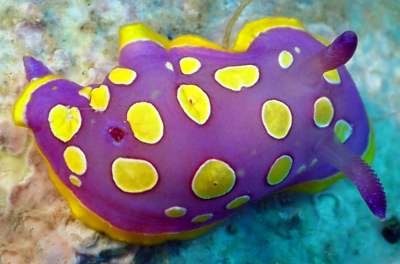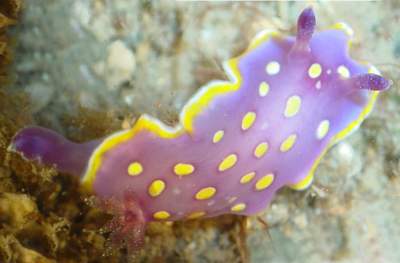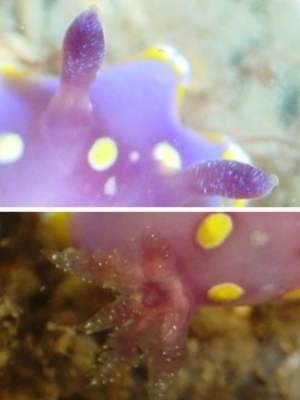Re: Chromodoris luteorosea? from Senegal
August 9, 2003
From: Marina Poddubetskaia


Dear Bill,
I'd like to come back to your thoughts concerning the presence or not of white spots on the gills and rhinophores in C. luteorosea. The upper photo is of a specimen from the Mediterranean. According to its very large spots I think there is no doubt that it is C. luteorosea. Somehow, it does not have white spots on the rhinophores. Moreover, a year ago I sent you a photo of this species [lower photo and see earlier message] in which these white spots on the gills and rhinophores can be seen well. So, I don't think that this characteristic should be considered as distinguishable in this species.
Upper Photo:
Date: July 11, 2003
Location: Cerbere, France, Mediterranean coast
Site: Les Chambres
Depth: 12m
Size: 20-25mm
Lower Photo: see earlier message.
Photos: Marina Poddubetskaia - Nembro website
Cheers,
Marina.
nembro@nembro.info
Poddubetskaia, M., 2003 (Aug 9) Re: Chromodoris luteorosea? from Senegal. [Message in] Sea Slug Forum. Australian Museum, Sydney. Available from http://www.seaslugforum.net/find/10641
Thanks Marina,
As I said in my earlier message, the differences between C. luteorosea and Chromodoris luteopunctata seem to be part of a continuum. The differences I mentioned, such as white spots on gills and rhinophores had been suggested by local experts. Your animal from Senegal clearly had features of both 'species', as does your lower photo in this message. [I have added a close-up of the gills and rhinophores of your lower photo to show the white spots said to be 'typical' of C. luteopunctata].
One problem with sorting out the Mediterranean 'blue chromodorids' has I think been the lack of sufficient material. Until we have a more complete understanding of the total colour variation within a species then deciding just what characterises each species is impossible. While in some cases major anatomical differences can be found between two very similarly coloured species, in other cases there are few anatomical variations and they are difficult to characterise. So again I think we need to look at biological characters - such as what each species eat and what egg masses look like etc.
Best wishes,
Bill Rudman
Related messages
-
Re: Chromodoris luteopunctata? from NE Spain
From: Angel Valdes, July 3, 2008 -
Re: Chromodoris luteopunctata? from NE Spain
From: David Abecasis, July 2, 2008 -
Chromodoris luteopunctata? from NE Spain
From: Jordi Regàs, October 11, 2007 -
Chromodoris luteorosea from Pantelleria Is., Italy
From: Jordi Regàs, October 11, 2007 -
Re: Chromodoris luteorosea from below
From: Adam Petrusek, October 16, 2003 -
Re: Chromodoris luteorosea from below
From: Adam Petrusek, October 13, 2003 -
Chromodoris luteorosea from below
From: Adam Petrusek, October 12, 2003 -
Chromodoris luteorosea from Tunisia
From: N. & B. Mansuy, August 21, 2003 -
Chromodoris luteorosea? from Senegal
From: Marina Poddubetskaia, June 23, 2003 -
Chromodoris luteorosea from France
From: Marina Poddubetskaia, July 25, 2002 -
Chromodoris luteorosea & C. luteopunctata
From: J. Lucas Cervera, February 5, 2001 -
Re: Chromodoris luteorosea from Spain
From: Juan Lucas Cervera, January 28, 2001 -
Re: Chromodoris luteorosea from Spain
From: Angel Valdes, January 28, 2001 -
Chromodoris luteorosea from Spain
From: Alma Sánchez, January 26, 2001
